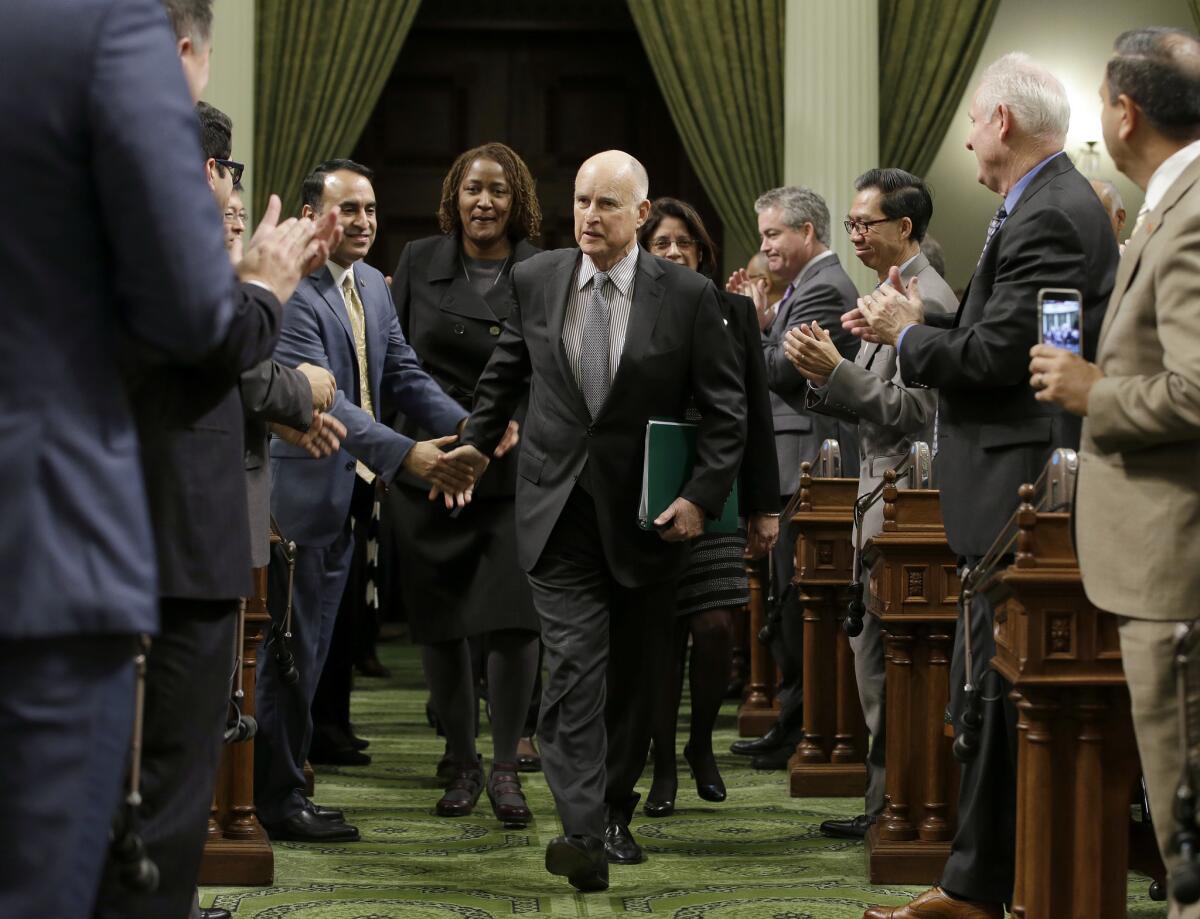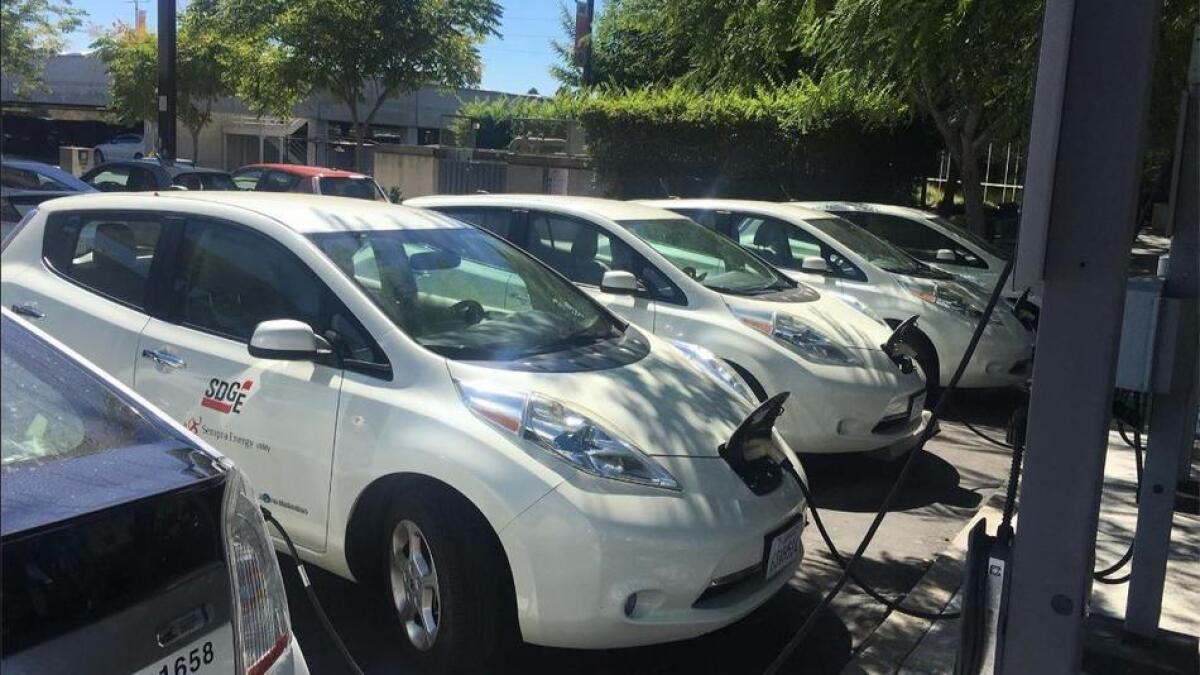As the White House changes course on climate change, California stubbornly presses forward

Reporting from Sacramento — With cheese and shrimp cocktail piled on their plates, guests strolled the exhibit like patrons at an art gallery, sipping beer and pausing to ponder the displays that lined the room. But instead of paintings or sculptures, they were examining scientific charts about climate change at a state environmental agency.
At a time when President Trump’s new administration is ordering federal government scientists to stop communicating with the public, the array of data depicting carbon sequestration, ocean acidification and water temperatures at a conference on climate change was for some a political act of defiance.
“We just have to push even harder than before,” said Patricia Hidalgo-Gonzalez, a UC Berkeley student who brought her research on the electricity grid. “Regardless of what happens in the rest of the country, California is going to stick with clean energy. We can be our own little island.”
It’s a stance that will be tested as California doubles down on its climate policies even as Trump steps back from the battle against global warming. And despite the bravado displayed last week at a conference on climate change hosted by state government officials, there was pervasive anxiety about the future as well.
“I’m worried,” said a federal scientist at the exhibit who asked to withhold his name because he feared retaliation. Fearful that the Trump administration would strip climate information from government websites, he said he asked his team to start downloading information so they could continue their work.
California has always charted its own course on cleaning up the air, clamping down on tailpipe emissions decades ago to fight smog in Los Angeles before the U.S. Environmental Protection Agency was even created in 1970. But the gap between Sacramento and Washington was growing into a chasm only a week after Trump took the oath of office.
The president is greenlighting oil pipelines that were rejected by President Obama. He told car manufacturers that regulations are “out of control,” and Oklahoma Atty. Gen. Scott Pruitt, his nominee to lead the EPA, expressed doubts about the severity of climate change during his confirmation hearing.
Meanwhile, California is moving to dramatically slash its greenhouse gas emissions, and Senate leader Kevin de León (D-Los Angeles) recently floated the possibility of generating all of the state’s electricity from renewable sources such as solar and wind. Major utilities have proposed a $1-billion investment in electrifying the transportation network, including more charging stations for cars.
It’s created a sense of dissonance for Californians, who are hunkering down even as they keep a wary eye on what’s happening on the opposite side of the country.
“You turn on the TV at night, and you hear these terrible things that are happening,” said Kip Lipper, who works on environmental legislation for the state Senate. “I tell my daughter, it’s good to be cognizant of that, but this is the best place to be, in California.”

California emits only 1% of the world’s greenhouse gases, but the state has tried to transform itself into an international model for fighting global warming. While Trump talks about withdrawing from the Paris climate accord, officials here continue seeking new partners for the state’s own, more ambitious international agreement.
Gov. Jerry Brown, in his State of the State speech Tuesday, said California wouldn’t step back from its agenda no matter what happens in Washington, a message repeatedly emphasized by top state leaders at the climate conference.
“This is when you do your best work,” said John Laird, secretary of the Natural Resources Agency. “We can’t worry about pulling back just to sink with everyone else who isn’t moving at all.”
The conference was planned before Trump won the presidency, but the results of the election created a charged atmosphere among the hundreds of scientists, government officials and advocates who showed up. Attendees talked about being “resolute in our values,” or how there’s a “major threat before us,” or how strong policies are needed “now more than ever.”
“There’s a greater seriousness in the room,” said Jonathan Parfrey, executive director of Climate Resolve, a Los Angeles-based nonprofit that helped organize the two-day event.
California’s climate agenda remains controversial, and some business interests believe the state is putting itself at a competitive disadvantage by ramping up regulations. The state’s premiere initiative — the cap-and-trade program, which requires companies to purchase permits to release greenhouse gas emissions into the atmosphere — is the target of an ongoing legal challenge.
But the week’s events were also a reminder of how much further the state has moved past the national conversation about climate change. Debates revolve around how global warming should be addressed, not whether it should be, or whether it’s even real at all.
Three consecutive state administrations have pushed the state’s policies forward. Gov. Gray Davis, a Democrat, approved the country’s first rules for regulating greenhouse gases from vehicle tailpipes. Gov. Arnold Schwarzenegger, a Republican, signed legislation setting an overall goal for reducing emissions in the state. Last year Brown enacted another law setting a new, stiffer target.
A broad network of organizations — environmentalists, energy entrepreneurs and developers of carbon offset projects — has sprouted and expanded around these policies.
As further evidence, the conference hosted by state officials wasn’t even the only event in Sacramento last week dedicated to California’s climate agenda. Another gathering across town drew visitors from as far away as Australia to discuss the future of the cap-and-trade program.
No one there expected the state to change course.
“There’s a whole ecosystem built to reduce emissions,” said Jon Costantino, an environmental policy advisor who previously worked at the California Air Resources Board. “There’s investors, there’s businesses, there’s consultants.”
He added, “To pull the rug out from under that would have a dramatic impact.”
Twitter: @chrismegerian
ALSO
Earth sets heat record in 2016 — for the third year in a row
Updates on California politics
More to Read
Get the L.A. Times Politics newsletter
Deeply reported insights into legislation, politics and policy from Sacramento, Washington and beyond. In your inbox three times per week.
You may occasionally receive promotional content from the Los Angeles Times.











